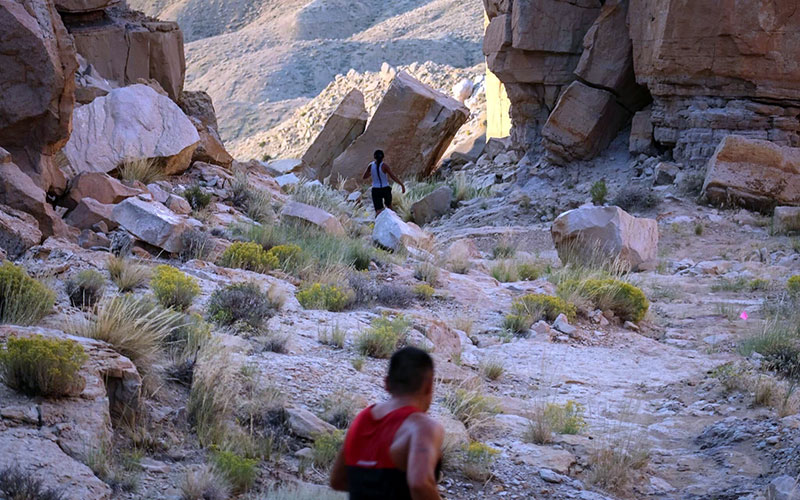Every year for 46 years, hundreds of runners met at the village of Shungopavi, Second Mesa, on Hopi land, to race in honor of Louis Tewanima, a Hopi who won a silver medal in the Olympics in 1912.
It was a gathering of community.
“We see the camaraderie when all the runners are there, they know each other,” said Max Taylor, Tewanima’s nephew.
This year, the COVID-19 pandemic forced a change into how the race will be conducted, but the event will still foster community and honor Tewanima, a humble man who was a great runner, organizers said.
All of the participants – up to 150 people total – will start at the same time on the morning of Sept. 6. But the location of the 47th annual Louis Tewanima 10k Footrace will expand.
The race will be virtual.
“A virtual race is a race that can be run (or walked) from any location you choose. You can run, jog, or walk on the road, on the trail, on the treadmill, at the gym, or on the track (or even at another race),” according to the race website. “You get to run your own race, at your own pace, and time it yourself. ”
Usually, 200 to 300 runners participate every year, but organizers limited the number of virtual participants this year. Elsewhere in the U.S., races such as the Boston Marathon have been canceled because of the pandemic. But organizers of the footrace wanted it to go on while still keeping people safe.
Louis Tewanima was the first and only Hopi to represent the United States in the 1908 Olympic Games in London and the 1912 Games in Stockholm, Sweden. At the games in 1912, Tewanima won a silver medal for running a time of 32:06.6 in the 10,000-meter race – a U.S. record at the time.
The record would last for 52 years until the 1964 Tokyo Olympics, when Billy Mills, a Native American from South Dakota, ran a time of 28:24.4 and won gold in the 10,000-meter race.
Sam Taylor, Tewanima’s grandnephew and the race organizer, said that as a child, he never really took much interest in the history of his Olympian relative. But he later realized the significance of Tewanima’s record.
“As I got older, I began to realize that that’s a huge freaking accomplishment – he’s an Olympian and one of the only Natives to ever represent their country,” Taylor said. “It really caught on, especially when I started running, especially when I started really helping. And I saw that their family was pretty much burnt out” after organizing a race that was established in 1974, according to the tewanimafootrace.org website. (The event in recent years had included a communal meal for runners the day before the race.)
Taylor took responsibility as the lead organizer for the event, saying “it’s become a mission.”
Despite his status as an Olympic athlete, Tewanima did not brag about his achievements. He would return to Carlisle Indian Industrial School, a boarding school he attended, and pick up where he left off.
“I think one of the things that really stuck out to me was that Louis Tewanima truly was a humble man,” said Matthew Sakiestewa Gilbert, a professor who oversees American Indian Studies at the University of Arizona.
“There are these accounts where Louis Tewanima would win a race, and he was winning races, track and cross-country events up and down the Eastern Seaboard. And he just wouldn’t even think much about these awards. Sometimes, he would forget the awards and have to be reminded that, ‘No, you’ve got to take this back to the school.'”
Taylor, Tewanima’s grandnephew, also noted how his attitude remained unchanged after he represented the U.S. at two Olympics, thousands of miles away from home.
“He was so humble about it, that when he came home, it was nothing,” Taylor said. “He returned back into normal Hopi life.”
Gilbert said Tewanima’s achievements were recognized by the Hopi community during his lifetime.
“These awards, these medals, these trophy cups certainly meant a lot to his peers. They meant a lot to those students at the Carlisle Indian School who were rooting him on, who were supporting him, who were writing about him in the Carlisle Indian newspaper.”
Tewanima’s descendants say the race – no matter where it starts or how it’s conducted – brings attention to his life and achievements and inspires the generations that followed him.
“We’re keeping his memory alive,” Max Taylor said. “It does encourage a lot of our young folks and even back to our elders to get back into running. Through this race, we’ve encouraged a lot of people to get back into running and improving their health. I think it’s a great thing that we’re doing by remembering him and having this race in his honor.”
Reporter José Solís contributed to this story.


